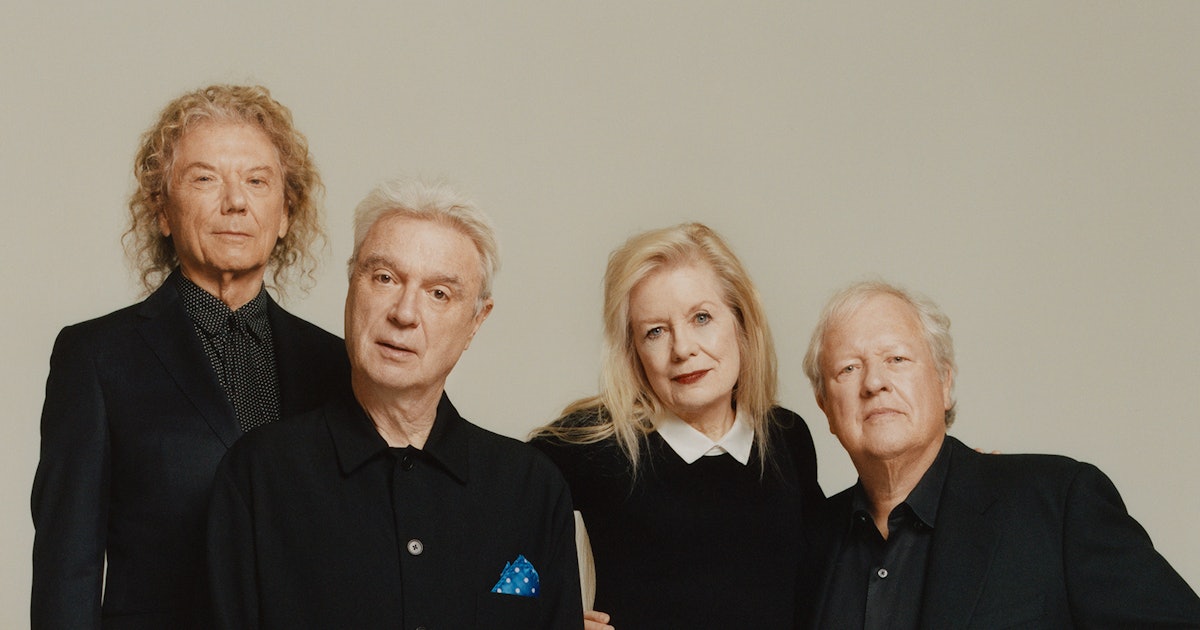Your 1984 film, Stop Making Sense, was recently rereleased by A24. Its raw simplicity stands in contrast to the highly produced stadium tour films of today, and it is still widely regarded as the greatest concert film ever made. Was it your aim to do away with the smoke and mirrors so the audience could focus purely on the music?
David Byrne: The emphasis really goes to the performers when you remove all of that stuff from the show. As an audience member, I’ve discovered that you’re more interested in seeing people than you are in seeing fireworks. Fireworks make you go “ooh” and “aah,” but it’s people—and the interactions between them—that really move you.
Do you think that’s why it continues to resonate, particularly with younger audiences?
Jerry Harrison: I’ve seen the film more than anyone, and to this day I will see a glance, a communication, or a nuance that I’ve never seen before. As an older person, having had different experiences in your life, you interpret things in a new way. There’s a human side to it that allows people to find newness in it, almost endlessly.
Tina Weymouth: We came out of CBGB in a time of over-the-topness in music, kind of like now. Everything was just overkill, like banks of synthesizers and double drums. As a team, we had amazing chemistry, and we came up with all of this through supportive collaboration. It was very beautiful and very special.
Even though you are associated with the punk bands of the CBGB era, your sound and aesthetic are remarkably different. How did being a part of that tight-knit community impact you artistically? Did you always set out to distinguish yourselves from punk?
DB: We all loved the other bands that were coming up alongside us. It was a really exciting time! We also felt that we had to discover what was unique to us and not just inherit the rock ’n’ roll poses, shapes, or guitar styles that were already out there, or to play the role of the “rock star.” We wanted to express something that had meaning for us—and for our generation.
Chris Frantz: A lot of the people who came to CBGB on a regular basis who were friends with the Ramones, Television, Patti Smith, or Dead Boys didn’t really get Talking Heads at first because we had more of a kinship, aesthetically, with the downtown art scene.
TW: We all grew up with really great garage rock, like the Stooges. We liked that very direct approach: Let’s see what you can do with your instrument without all of the fancy technology. How can you keep it vital and defiant at the same time? We went to art school, so we understood that the Ramones and the Dictators looked at us and thought, They’re so arty. But we were just as strange and eccentric as they were!
Were you ever told you were too strange to be commercially successful?
TW: Absolutely! We had a girl in the band who was just learning to play the bass guitar. They didn’t like our clothes; they said they weren’t rock ’n’ roll. There were so many things we were doing “wrong.”
JH: We far exceeded our initial expectations of commercial success. We set out to have artistic success and to be recognized by our peers—the music community and the downtown community. We felt that what we were doing was unique and worthy of their attention. But we were also not lazy. We toured relentlessly! I think Talking Heads and the Ramones were the two hardest-working bands to come out of that scene. Because the scene was ignored by major record labels for a couple of years, this allowed everyone to really home in on what they wanted to say. It allowed people to develop their art before it was exposed to a larger audience. There was something magical about that hothouse of mutual development.
Hair by Kiyonori Sudo for R+Co at L’Atelier NYC; Makeup by Kiki Gifford at Streeters. Photo Assistants: Jordan Zuppa, Ariel Sadok; Fashion Assistant: Tori López; Makeup Assistant: Min Hong; Tailor: Lindsay Wright.

